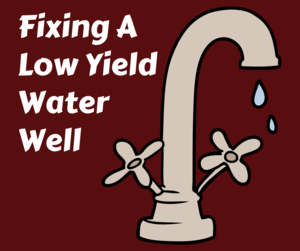CALL TODAY 1-800-441-6281
CALL TODAY 1-800-441-6281

How To Repair A Water Well That’s Run Dry
A well-running dry is not a common occurrence in New Hampshire and Massachusetts, but it is not unheard of. If you’ve noticed lots of air in the water system, that you are running out of water after heavy usage, like watering the lawn, or your water pressure is very low, your well could be running dry. Homeowners today have a number of options when it comes to replacing a dry well wells, but first, they must determine if the well has actually run dry or if the problem is caused by a mechanical failure.
IDENTIFYING THE PROBLEM
Air in the system and other problems might be caused by your well running dry, but they can also be symptoms of a hole in the pipe, faulty electrical wiring, or a water pump malfunction. Calling water well specialists like Skillings & Sons to examine the system and pull up your well pump and examine it for problems could end up saving you thousands of dollars. Running the pump at a different level in the pipe – also known as the casing – can also show whether the well is truly running dry or if there is another problem that’s more easily resolved.
WHEN IT’S RUNNING DRY
If the specialist determines it’s not a mechanical problem, there are a few additional steps you can take before drilling an entirely new well that will save you money and headache.
Check the age of the well. Most wells are designed to last between 20 and 30 years before their yield drops, depending on the type of well and its construction. Sediment and mineral scale can build up over time, also reducing the yield. Your well may need a cleaning to clear the build-up, which can be done chemically or mechanically by a water well specialist.
CHECK THE WATER PUMP LEVEL.
Water pumps should be located below the water table to provide an extra buffer of water when the well draws down during home usage. A well drilling company can pull the pump and measure the current water level, as well as the depth of the well. In some cases, the pump can be placed lower, giving more of a water buffer that prevents running out of water.
Hydrofracturing can increase water flow. Hydrofracturing, or hydrofracking, is a process in which water is injected into the well at a high-pressure to clear fissures in the bedrock of debris and clear the way for better water flow. Skillings & Sons has had great success with this hydrofracking, which increases flow 98% of the time. It’s so successful, we offer a guarantee on existing wells.
Water well deepening may help your well yield increase. However, this can be just as expensive as drilling a new well and may not yield the best results. Sometimes, drilling a new well is the best option. If your existing well is older than 30 years and the flow was not increased using other methods, it may be time to drill a new well. A modern well may be able to produce more water for the home, even on the same property, depending on depth and location. Once a new well is drilled, the old existing well must be sealed to protect the groundwater from contamination and as a safety precaution.

